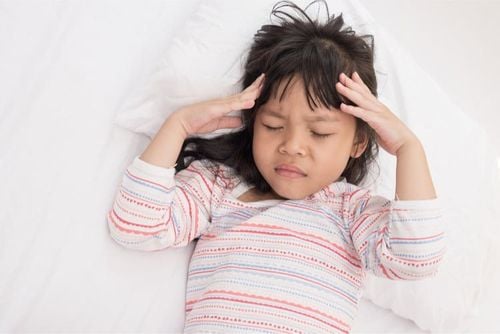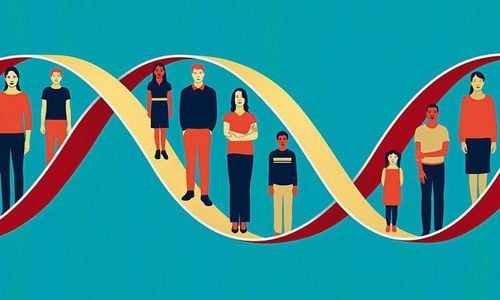This is an automatically translated article.
Headache in children is a headache sensation and this pain is not distributed according to the sensory regions of the nerve. Headache is a common symptom, 10% of children come to the neurology clinic because of headache, of which 40% are under 7 years old.1. Headache in children
Headaches in young children can be primary or secondary. A secondary headache is just a symptom of some other condition while a primary headache is a headache without any other medical cause.Migraine is a major type of headache. Even tension headaches are considered the main types of headaches. Tension headaches often lead to pain in the head and temples.
At least 10% of children have migraines. This type of headache in children causes severe pain and can be troublesome for children for many hours. Children may even vomit.
Secondary headaches can be the result of an infection, anxiety, depression, sinus problems, or mild pain in areas like the neck or head.

Cluster headaches in young children can occur in children 10 years of age and older. These headaches can even last 7 days or more. Pain may appear behind the eye. This can be followed by red and watery eyes. The eyes and forehead may even swell.
Frequent headaches in young children can also be caused by tumors. So if your child complains of a constant headache, it is best to take him to the doctor to detect the disease in time.
Trắc nghiệm: Nhận biết sớm dấu hiệu chậm phát triển thể chất và trí tuệ ở trẻ
Nếu 6 tuổi không biết đếm số, 7 tuổi vẫn chưa phân biệt được giữa thực tế và tưởng tượng thì có thể bé chậm phát triển thể chất và trí tuệ hơn so với bạn bè cùng lứa. Bạn đã nhận biết được các dấu hiệu bất thường sớm này chưa? Cùng làm nhanh bài trắc nghiệm sau để trang bị thêm kiến thức cho mình nhé!
The following content is prepared under supervision of Thạc sĩ, Bác sĩ y khoa, Ma Văn Thấm , Nhi , Phòng khám Đa khoa Quốc tế Vinmec Dương Đông(Phú Quốc)
2. Causes of headaches in children
Illnesses and infections Common illnesses such as colds, flu, and ear and sinus infections are some of the most common causes of headaches in young children. More serious infections, such as meningitis or encephalitis, can also cause headaches, but are often accompanied by other signs and symptoms, such as fever and stiff neck.Head trauma Bumps and bruises on the head can cause headaches. Although most injuries are minor, you should seek prompt medical attention if your child has had a hard fall or hit to the head. In addition, you need to take your child to the doctor right away if a headache in a child gets worse after a head injury.
Eye diseases Headaches in young children can also be caused by some eye diseases such as nearsightedness, astigmatism, and farsightedness that are not detected in time, so they do not use glasses to support or use glasses but do not have the right focus. In addition, there may also be some diseases caused by inflammation in the eyes such as conjunctivitis, acute lacrimal gland inflammation.
Emotional factors Stress and anxiety can be one of the causes of headaches in children. Children with depression may experience headaches, especially if they have trouble recognizing feelings of sadness and loneliness.
Genetic predisposition Headaches, especially migraines, tend to run in families.
Certain foods and beverages Nitrates - a food preservative found in cured meats, like bacon, bologna and hot dogs - can cause headaches. The food additive MSG can also cause this condition in children. In addition, too much caffeine - found in soda, chocolate, coffee and tea - can also cause headaches.
Brain problems A brain tumor or abscess or bleeding in the brain can cause chronic headaches in young children. This situation rarely occurs. Often in these cases, there are other symptoms, such as problems with vision, dizziness, and poor coordination.

3. Symptoms of headache in children
Each type of headache in children will have different symptoms. However, these symptoms mainly differ in the intensity of the pain, its duration, and how it affects your baby's daily activities. For example, migraine headaches are often accompanied by:Reduced vision Sweating Nausea and vomiting Sensitivity to light and sound Tension headache symptoms:
Mild to moderate pain and dull pain often on the sides of the head changing baby's sleeping habits Pain in the shoulders and neck The following symptoms in a child indicate that a headache is a sign of a serious illness:
Frequent headaches Sudden severe pain Headache upon waking Pain that gets worse when baby coughs, sneezes or moves his head Dull headache, mild to severe Nausea or vomiting with every headache Decreased vision Personality changes Legs become weak, having difficulty moving Seizures When children complain of headaches, parents need to be very concerned and consider accompanying symptoms. Depending on the symptoms of the child, the parents should take the child to the doctor for early treatment.
Children need to provide enough elemental zinc/day for them to eat well, reach the correct height and weight and exceed the standard. Zinc plays a role in affecting most biological processes taking place in the body, especially the breakdown of nucleic acids, proteins... Organs in the body when zinc deficiency can lead to a There are a number of diseases such as neurological disorders, irritability, etc. Therefore, parents need to learn about the role of zinc and guide them to appropriate zinc supplements for their children.
In addition to zinc, parents also need to supplement their children with other important vitamins and minerals such as lysine, chromium, B vitamins,... errands.
Please regularly visit Vinmec.com website and update useful information to take care of your baby and family.














